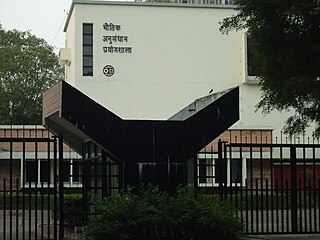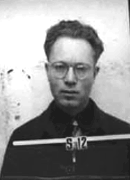
The following outline is provided as an overview and topical guide to space science:

The National Superconducting Cyclotron Laboratory (NSCL), located on the campus of Michigan State University was a rare isotope research facility in the United States. Established in 1963, the cyclotron laboratory has been succeeded by the Facility for Rare Isotope Beams, a linear accelerator providing beam to the same detector halls.
United States federal research funders use the term cyberinfrastructure to describe research environments that support advanced data acquisition, data storage, data management, data integration, data mining, data visualization and other computing and information processing services distributed over the Internet beyond the scope of a single institution. In scientific usage, cyberinfrastructure is a technological and sociological solution to the problem of efficiently connecting laboratories, data, computers, and people with the goal of enabling derivation of novel scientific theories and knowledge.
Solar physics is the branch of astrophysics that specializes in the study of the Sun. It deals with detailed measurements that are possible only for our closest star. It intersects with many disciplines of pure physics, astrophysics, and computer science, including fluid dynamics, plasma physics including magnetohydrodynamics, seismology, particle physics, atomic physics, nuclear physics, stellar evolution, space physics, spectroscopy, radiative transfer, applied optics, signal processing, computer vision, computational physics, stellar physics and solar astronomy.

The Physical Research Laboratory is a National Research Institute for space and allied sciences, supported mainly by Department of Space, Government of India. This research laboratory has ongoing research programmes in astronomy and astrophysics, atmospheric sciences and aeronomy, planetary and geosciences, Earth sciences, Solar System studies and theoretical physics. It also manages the Udaipur Solar Observatory and Mount Abu InfraRed Observatory. The PRL is located in Ahmedabad.
Alastair G. W. Cameron was an American-Canadian astrophysicist and space scientist who was an eminent staff member of the Astronomy department of Harvard University. He was one of the founders of the field of nuclear astrophysics, advanced the theory that the Moon was created by the giant impact of a Mars-sized object with the early Earth, and was an early adopter of computer technology in astrophysics.
The Modular Neutron Array (MoNA) is a large-area, high-efficiency neutron detector that is used in basic research of rare isotopes at Michigan State University's National Superconducting Cyclotron Laboratory (NSCL), a nuclear physics research facility. It is specifically designed for detecting neutrons stemming from breakup reactions of fast fragmentation beams.

The Indian Centre for Space Physics (ICSP) is an Indian non-profit research organisation dedicated to carrying out advanced research in astronomy, astrophysics and space science. It is a sister institute of the University of Calcutta and the University of Gour Banga. It is located in the southern part of the city of Kolkata. It is shifting to its new Integrated campus on the Eastern metropolitan bypass 50 meters from Jyotirindra Nandy Metro station behind Metro Cash and Carry. Its Ionospheric and Earthquake Research Centre and optical observatory (IERCOO) where a 24-inch optical telescope (Vashista) has been installed. School and college students regularly carry out sky watching using its 10-inch telescope (Arundhati). The ground floor of the Integrated Campus will have an Astronomy and Space Museum which will be inaugurated very soon.

The Abdus Salam Centre for Physics, is a federally-funded research institute and national laboratory site managed by the Quaid-i-Azam University for the Ministry of Energy (MoE) of the Government of Pakistan.
The Hans A. Bethe Prize, is presented annually by the American Physical Society. The prize honors outstanding work in theory, experiment or observation in the areas of astrophysics, nuclear physics, nuclear astrophysics, or closely related fields. The prize consists of $10,000 and a certificate citing the contributions made by the recipient.

Hendrik Schatz is a professor of Nuclear Astrophysics at Michigan State University. He earned his Diploma from the University of Karlsruhe in 1993, and his PhD from the University of Heidelberg in 1997 after completing his thesis work at the University of Notre Dame. He is one of the Principal Investigators for the Joint Institute for Nuclear Astrophysics and is a leading expert on nuclear astrophysics,. Schatz also serves the science advisory committees for the Facility for Rare Isotope Beams and GSI. Hendrik's primary field of expertise is Type I X-ray Bursts. His most notable contribution to this field is the discovery of the SnTeSb-cycle. Hendrik was featured in Science magazine November 22, 2002 for his work on experimental nuclear astrophysics. Hendrik has also contributed to Physics Today.

Bernard Waldman was an American physicist who flew on the Hiroshima atomic bombing mission as a cameraman during World War II.

The College of Science is a college within the University of Notre Dame. The Dean of the College of Science is Santiago Schnell, appointed Sept 1st, 2021.
Robert Graham Hamish Robertson is a Canadian–American experimental physicist, specializing in neutrino physics. He is a Professor Emeritus at the University of Washington, where he was formerly the director of the University of Washington's Center for Experimental Nuclear Physics and Astrophysics.

Boris Pritychenko is a Russian–American nuclear physicist. He compiles experimental data, works on nuclear databases, and serves as editor-in-chief of the journal Atomic Data and Nuclear Data Tables.

Timothy C. Beers is an American astrophysicist. Beers teaches at the University of Notre Dame in the Department of Physics (2014–present), where he holds the Notre Dame Chair in Astrophysics. He is a co-founder of the Physics Frontier Center Joint Institute for Nuclear Astrophysics – Center for the Evolution of the Elements. Prior to coming to Notre Dame, Beers was Director of Kitt Peak National Observatory (2011-2014), and for 25 years was a professor in the Department of Physics and Astronomy at Michigan State University (1986-2011), retiring from that position as University Distinguished Professor.
Ani Aprahamian is a Lebanese-born Armenian-American nuclear physicist. She has taught at the University of Notre Dame since 1989. She is currently Freimann Professor of Physics at Notre Dame. She has been director of the Alikhanyan National Science Laboratory in Armenia since April 2018, the first woman to hold the position.

Meenakshi Narain was an Indian-born American experimental physicist. She was a Professor of Physics and Chair of the Department of Physics at Brown University, and was also Chair of the Collaboration Board of U.S. institutions in the Compact Muon Solenoid (CMS) Collaboration. She contributed to the discovery of the top quark in 1995 and Higgs Boson in 2012.
Michael C. F. Wiescher is a German-American experimental nuclear physicist and astrophysicist, known for his laboratory research in nuclear physics connected with various astrophysical phenomena such as stellar evolution and explosion environments.










